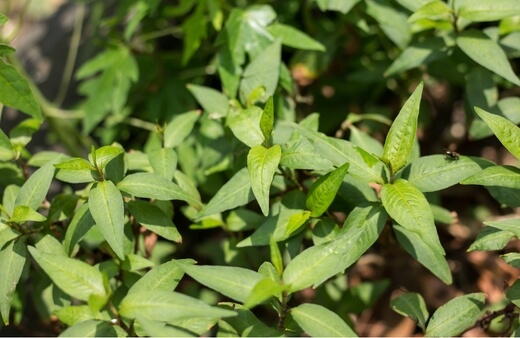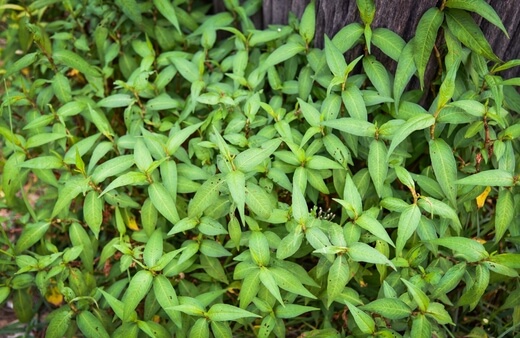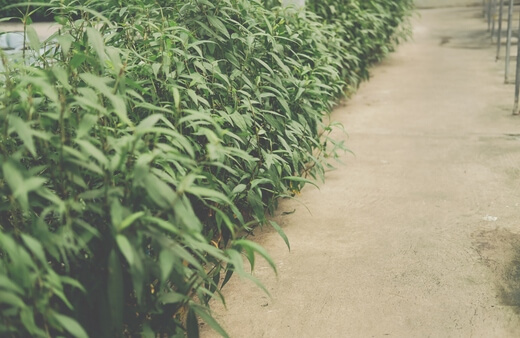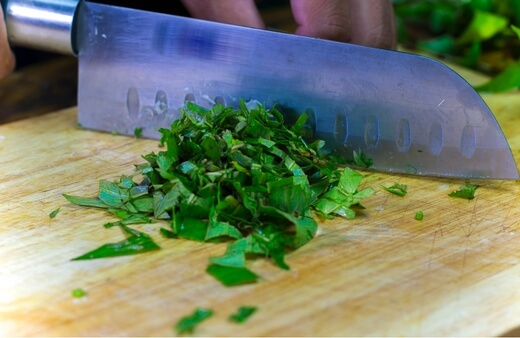If you’re looking to get a taste of Southeast Asian cuisine here at home in Australia, may I recommend the Vietnamese mint. It’s used much like coriander and has a great flavour. I say the more, the better.
The joy and satisfaction of growing my own herbs gives me such a kick just to know that I can eat something I grew myself. No doubt you’ll grow to love it too. Luckily, this plant is good looking too and super easy to care for. Just my kind of plant.
In our how to grow and care guide, we’ll introduce you to the lovely Vietnamese mint. We’ll talk about propagation of your own plant, how to care for it in terms of light, watering, and feeding, go through pests and diseases to look out for, and end off with some frequently asked questions.
More...

Family: | Polygonaceae |
|---|---|
Genus: | Persicaria |
Species: | P. odorata |
Common Names: | Vietnamese mint, Vietnamese coriander, laksa leaf |
Location: | Indoor or outdoor |
Type: | Evergreen perennial |
Growth: | Up to 40 cm tall, Up to 60 cm wide |
Sun requirements: | Full sun to part shade |
Foliage Colour: | Lime green with dark markings in the middle |
Flower Colour: | Small, light pink |
Flowering: | Spring and summer |
Fruit: | None |
Maintenance level: | Low |
Poisonous for pets: | No |
Introducing Vietnamese Mint

You would assume that the common name of Vietnamese mint reveals where it’s native to. In this case, it’s not just native to Vietnam and the plant isn’t actually related to the mint family as we know it.
So the name is a bit mysterious then! The Persicaria odorata is popular in Southeast Asian cooking which might help to explain the name better. The plant has a good fragrance, you can eat it, and use it to decorate your home and garden.
In the kitchen, Vietnamese coriander adds some spice to things like salads and spring rolls. The flavour profile is quite unique but has a lot of depth.
Vietnamese Coriander Plant Features
You might find it surprising that Vietnamese mint is in fact part of the knotweed family – if that rings a bell, it might be because some very pesky weeds are also part of this plant family.
What it does mean, is that laksa leaf is easy to grow. Proof of this is if you propagate a plant stem in water, you might see roots as quickly as a few days and you could plant the cutting about a week later. In the wild, it would usually be found along a riverbank.
You’ve got some flexibility when deciding where to plant your Persicaria odorata as they can do full sun or part shade. You can also grow it in the garden, or in a pot. We’ve got a whole category on pots and planters where we talk about the best hanging basket ideas, self-watering pots, and vertical gardening.
Vietnamese mint is considered a spreading herb and you’ll know it by bright green leaves with black markings. The stems of this plant can grow up to around 40cm in the warmer seasons and will delight with lots of little pink flowers.
The Vietnamese coriander stems like to creep and explore and send out roots from their leaf nodes. It has a shallow root system.
Growing Vietnamese Mint in Australia

Propagating Vietnamese mint
A good time to grow Vietnamese mint is during the spring or summer time. If it’s warm and sunny, your plant will be happy. The easiest way to propagate this plant is by using cuttings.
You want to use a stem that is thick enough and looks healthy, about 15 cm in length. Remove about a third of the leaves and then pop the cutting in some clean water to allow it to grow roots.
When you take your cutting, aim for one that has roots you can see already. The propagation time is about 4 weeks. You can plant the cutting somewhere that has part shade to begin with.


Get Your Free Guide:
Master Growing Australian Natives eBook
A Must Have Complete Guide for Every Australian Garden
Get Your Free Guide:
Master Growing Australian Natives eBook
A Must Have Complete Guide for Every Australian Garden
It’s recommended that you pinch out the tips of the plant when planting it. This actually promotes leaf growth and thicker stems.
How to Care for Vietnamese Coriander

Sunlight Needs
This mint is versatile when it comes to sunlight – opt for full sun or part shade, whatever your garden or home allows for.
Soil Preference
Vietnamese mint likes loamy soil that is slightly acidic.
Watering Laksa Leaf
The soil surrounding your Persicaria odorata should be kept moist at all times. Feel the soil and if it’s dry, give it some water. Vietnamese coriander often grows in very shallow water so if there is a bit of overwatering, it’s not actually an issue for this particular plant.
What Fertiliser to Use
You should aim to fertilise your plant each month. The Vietnamese mint loves a frequent fertiliser dose and you’ll see it really thrive when you do. A good guideline is to fertilise twice a month in the warmer weather and in colder seasons you can do it once per month.
Using something like a liquid seaweed fertiliser is ideal for your Vietnamese mint.
Pruning Vietnamese Mint
A regular pruning is a must for laksa leaf (good news for your kitchen). It needs to be controlled otherwise it could take over your garden and take nutrients from other plants. You can cut back leaves and stems accordingly once or twice per month.
Pruning also promotes a bushy look and will keep it growing happily. You’ll see how quickly it grows back once it’s been cut. You can prune Vietnamese coriander by about half at the end of winter.
How to Use Vietnamese Mint

The fact that Vietnamese mint is also called Vietnamese coriander and hot mint probably tells you a lot about the flavour profile. First, let’s just clear up that this particular mint is not actually related to the mint we are more familiar with. It looks like mint and smells like mint, but Persicaria odorata has a little more kick to it.
Much loved in Southeast Asian cuisine, you’ll often find laksa leaf used in things like a chicken salad or curry, in soups and noodle dishes. You can pop this mint in a stir fry for example, or even just have it fresh in a salad. (Here are some Vietnamese mint recipes you can try.)
Aim for the young leaves – the older ones don’t have a great flavour. If you are wanting to store your pickings for a few days, you can keep the mint in the fridge and aim to use it within a week.
Vietnamese mint might not offer much in terms of nutrition but the oils from the plant have powerful anti-bacterial and anti-inflammatory qualities. If you’re dealing with stomach issues like cramps or indigestion, Vietnamese mint is great for these ailments.
Vietnamese Mint Pests and Diseases to Look Out For
Aphids and spider mites are the most common pests to look out for on your Persicaria odorata. Let’s look at each in a bit more detail below.
Aphids
These creepy crawlies usually cause the leaves of your Vietnamese coriander to take on a strange shape, to start curling up or becoming yellow. You might also notice that your plant has stunted growth.
You could use an insecticidal soap or oil to treat your mint. Neem and canola oils are the common ones and work really well to smother the aphids.
Spider mites
If you’re dealing with spider mites, you might notice that the leaves of your plant become speckled and after a while they start to turn yellow or red, eventually dropping off.
Your first line of defence is to hose down the mint to get rid of the pests and then you can follow on with your insecticidal treatments like neem oil. If you have a heavy infestation that doesn’t respond to the neem oil, then you’ll probably need a strong insecticidal soap.
Here are more tips on how to deal with spider mites and prevent them from coming back in your garden.
Vietnamese Mint Frequently Asked Questions

Do I need to bring my Vietnamese Mint inside for certain seasons?
If it’s possible, we would recommend that your Vietnamese mint come indoors for autumn and winter time. This mint is a lover of the warmer climate and the cold could kill it off.
Why is it recommended to pick off the flowers of Vietnamese mint?
You’ll notice that the little flowers of this mint grow together in a bunch. You can cut these off when you notice them so the plant can rather use energy for growing its gorgeous leaves.
How soon can I harvest my Vietnamese mint?
It’s a good recommendation to wait for at least a month before you harvest your Persicaria odorata. Just to confirm the timeline, this is a month from when the cutting was planted in the garden.
If you harvest the plant too early it can cause damage and will affect future growth. Your ideal time to harvest is at the end of spring or during the summer time.
Why is it recommended that you should harvest Vietnamese mint when it’s dry?
Herbs in general are better harvested when they are dry so later in the day is best after morning dew and any watering.
Get more gardening inspiration and advice when you subscribe to our newsletter here. We offer top gardening tips for everyday people.Wrapping Up Our Vietnamese Mint Growing and Care Guide
Mint in general brings up images of freshness, cool drinks, and delicious meals. Although Vietnamese mint is not your usual mint family, it has its own culinary benefits and botanical beauty. The leaves are pretty, it’s super simple to propagate, and if you filled your whole home with this plant, it wouldn’t be too much.
I am a big fan of giving people plants rather than bunches of flowers to celebrate an occasion or as a gift. I think a plant like the Vietnamese mint is a great choice – whether your gift recipient has green fingers or not, they can keep the plant indoors or outdoors, they can use it in their kitchen, and you can’t really overwater Vietnamese mint!
Published on November 7, 2022 by Maisie Blevins
Last Updated on February 22, 2024




